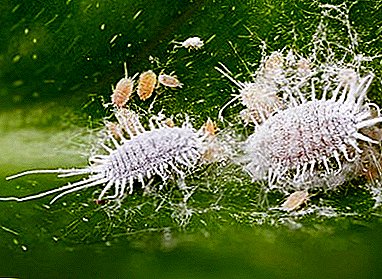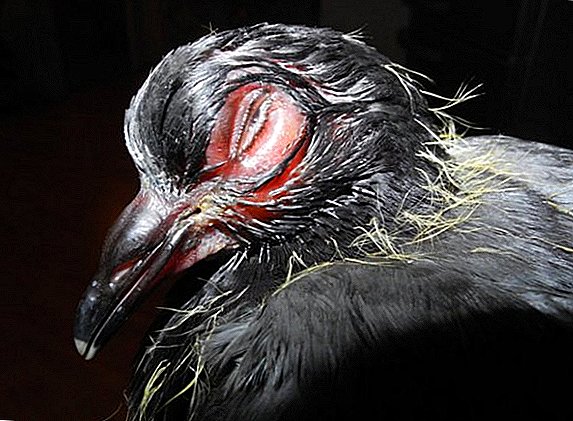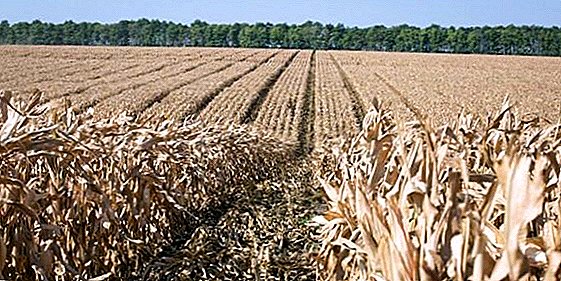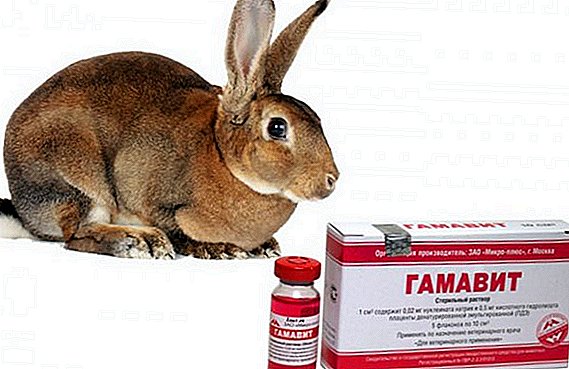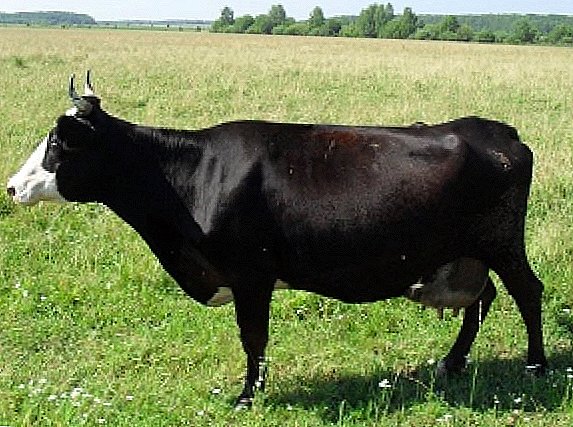
Milk is the very product from which our life begins. It is capable of transmitting all the most necessary components for life and development.
It is for this reason that many livestock breeders are breeding dairy cows. Such cows, even when kept free grazing, are capable of pleasing their masters with very high yields of tasty and fat milk.
To date, the selection and nature of the world produced a large number of cows of this type, therefore, if you want to get your own favorite, will choose from what.
We want to tell you in detail about the Yaroslavl breed of dairy cows, which is one of the most productive of its kind.
What is famous Yaroslavl Burenka: talk about the breed
This breed is called Yaroslavl because it was bred in this area of the Russian Federation. Moreover, no selection work has been applied to these cows.
The best dairy breed to date has been obtained as a result of many years of breeding for dairy qualities. However, the breeding work to improve the constitution, udder and, of course, improve milk production, is still underway.
The distribution of Yaroslavl cows is very wide, which was promoted not only by their merits, but also by their good adaptability.
In breeding and keeping the breed is very easy to get used to as a large herd, and to the individual content.
Thus, these cows are perfectly suited for both summer grazing on pastures with large amounts of green mass, and in sheds for feeding with concentrates and silage. The fecundity of cows is very high, which is very important for the reproduction of new generations.
Features of the appearance of representatives of the breed and their distinctive features

Most often, these beautiful cows are found in a black suit, although most of the head and lower torso are usually covered with white spots. The lower part of the limbs and the tip of the tail tassel are also white.
However, it is not necessary to call the breed black-ryabya, because some individuals do not have spots at all. However, as a result of cross-breeding with different breeds, some representatives of the Yaroslavl breed have a red-and-white suit.
In general, representatives of Yaroslavl cows can be distinguished by an angular constitution with a very strong constitution. The backbone of them is very strong and weighty, which is more characteristic of dairy cows and makes them less pliable to move over long distances.
The middle part of the body is best developed in these animals, the head is very light and dry. A remarkable feature of the breed is also elongated shape of the front of the head and an unusually dark nasal mirror.
The horns of them, though not very large in size, but quite strong, bright color. Another feature of Yaroslavl cows, as representatives of the dairy type of performance, is the average length of the neck. The skin on the neck consists of many small folds.
The disproportion of the body of the described breed of cows arose from the fact that their ribs are arranged very widely. Thus, the belly of animals looks very voluminous. But absolutely all the muscles of the body are developed very weakly, the muscle mass does not accumulate throughout life and is presented in the form of rather thin fibers.
Fench is also practically undeveloped. It is for this reason that the use of the Yaroslavl breed as cows in the meat sector has absolutely no prospect, although in general the resulting meat yield from them is satisfactory.
Animal skin is quite thin, representing almost no value for the leather industry. Due to thin skin and poor fat accumulation, representatives of the breed are quite susceptible to temperature extremes.
Their content should assume shelter in hot weather, and in frosty content in warm barns without drafts and, preferably, with heating.
The main parameters of Yaroslavl cows: how large is the cattle?

The height of these animals is quite large, even in spite of the characteristic short legs (the bones of the legs are rather thin, which is why animals often suffer).
In particular, the growth of a cow at the withers averages only 125-127 centimeters.
There are no particular differences in growth between cows and bulls.
Also, there are no particular differences in the measurements of animals, and there are no different parameters, the bulls all the same reach larger sizes:
- The average length of the oblique torso line is 152-155 centimeters.
- The chest in animals is not deep, from 66 to 70 centimeters, and in width its parameters are 35-37 centimeters.
- Metacarpus in girth is 17-18 centimeters.
In general, the impression from these cows can be said that their bodies are very deep and stretched. Thus, we can conclude about the small size of the cows of the described breed, which of course can not be said about the bulls-inseminators, whose weight can go far beyond 1000 kilograms.
But, due to the compact build of cows, their maintenance and feeding will also not be difficult and financially expensive. Moreover, it is worth paying attention to the restrained disposition of animals, a characteristic feature become attached to the owners.
Features and distinctive characteristics of the udder of the breed
Udder of this dairy breed of cows is also one of the criteria by which it can be distinguished from all other relatives. It has a very large size, which allows you to accumulate large amounts of milk and easily carry it before the time of milking. It has a rounded shape, due to which it does not prevent the cow from moving even when it is full, and allows you to easily approach the animal during milking.
But the most important distinguishing feature of Yaroslavl dairy breed is the location of the nipples. Besides the fact that they have a medium length convenient for milking, they are placed as widely as possible from each other. At the same time, the distance between the pair of front nipples is much larger than the distance between the pair of rear ones. Also, the structure of the udder glandular. This means that after milking, it is several times smaller in size, it becomes very soft and spongy. In the back, small folds of skin are formed, which are an udder reserve.
It is also interesting to read about the best breeds of cows.
A very important indicator of milk production of cows is an indicator such as an udder index. It indicates exactly what the ratio is the total amount of milk, which gives the cow, to the yield of the two front quarters of the udder.
This index characterizes how evenly all the quarters of the udder are developed, which in turn makes it possible to speak about the productivity and health of individuals of cattle. For this breed, this figure is 40-44%, which indicates very high productivity her representatives.
It should also be noted that the skin of the udder of Yaroslavl cows is quite thin, which, with free grazing, often leads to injury. Dairy veins are moderately developed. In this regard, care and supervision of representatives of the breed should be very diligent, which will allow to obtain good results in the form of milk production.
What are the main advantages of the Yaroslavl breed?

Naturally, the main advantage of dairy cattle can only be indicators of its milk production. But, let's talk about it a little lower, but here we note the high fat content of milk, which averages 4.4% (a record high of 6.1%).
If we consider that the average fat index for all dairy breeds is at the level of 3.7%, then this result should be considered very high. It is also worth paying attention to the fact that the fatter milk is, the more high-quality it is and the more suitable it is for further processing.
No less important are the features of the immunity of these animals, which is able to fight back the most diverse diseases from which cows usually suffer. And the most important thing is that the Yaroslavl cow is the most resistant to leukemia of cattle.
This disease is very easily transmitted from animal to animal and today there are no ways to treat it. With the defeat of their animals inflicted a very strong damage to milk production.
But, even in the case of infection of one representative from the herd of the described breed, leucosis is unlikely to be transmitted to other individuals, although the necessary precautions will still need to be taken.
Great value this breed also because widely used in breeding. In particular, its genes have a good ability to transmit dairy characteristics, a bet on which scientists do.
It is a little about defects which are characteristic to the described breed
Among the shortcomings of the Yaroslavl breed can only be called flaws in their physique. In particular, it is a very narrow chest, with poorly developed muscles. Also, they have a very wide ass with a drooping and roof-shaped sacrum. In meat productivity, these are very negative indicators.
But most of the difficulties gives the animals themselves and their owners weak limbs. With free grazing, this is very often the cause of breaking of paws and dislocations, therefore, it is important to pre-level the area allocated to cows and eliminate places with difficult relief from it.
Also, when keeping and breeding the Yaroslavl weather, you need to be prepared for the fact that in the period after calving cows often fall on their front legs and can not stand on them for some time.
The Yaroslavl breed is famous for its productivity: in detail about everything
Possible milk yield and main characteristics of the milk produced

The milk productivity of Yaroslavl cows is simply impressive, since the average milk yield can vary from 2,700 to 3,500 kilograms of milk during the first lactation period.
Further yields just go up, and with proper and attentive care, as well as full feeding, their performance can increase to 5000-5500 kilograms, a record figure of 11,590 kilograms of milk.
But let's not be cunning, that this is the highest results of milk production of cows. Today, many foreign breeds of dairy cows have been developed, the productivity of milk yields of which are much higher than that described.
Yaroslavl cows retain their positions as the best of dairy breeds only because of the high taste qualities of milk and its nutritional properties.
Also, it has very good characteristics, one of which we have already mentioned - milk fat. But besides fats, it contains a lot of protein, the percentage of which reaches 3.5-3.7.
Meat productivity of the Yaroslavl breed of cows: what kind of beef can you get with good fattening?
It is clear that although the described breed is dairy, if a bull is born, in the future it is allowed for slaughter, and at a very early age.
Despite the fact that in general the musculature of these cows is developing very poorly, due to the large size of the animal, the amount of meat produced as a result still results in 55 to 62% yield.
If we take into account that, on average, the weight of the cows is 450-550 kilograms, and the weight of the bulls is from 700 to 1200 (usually, bulls usually reach such large numbers), then output rate is very high.
At birth, the weight of calves is usually 28-32 kilograms, but they immediately grow very intensively, especially if at least the first 6 months the calves are fed motherly // hundred and the average daily weight gain for bulls and heifers is different:
- Already by 6 months of fattening with the mother's milk, the heifer grows up to 160-170 kg, and by 18 months - up to 350-380 kg. The average daily increase is 700-750 grams.
- If you apply intensive fattening, then by the age of 1 year the weight of a bull usually reaches 800-900 kilograms. The weight gain is usually not less than 800 grams per day.
At the same time, in young individuals fat begins to be deposited rather early, due to which the bulls are allowed to be slaughtered at the age of 1 year. The fact is that from such young animals of the Yaroslavl breed you can get highly nutritious and tender beef.
When dairy cows are allowed to meat at a more mature age, their meat is no longer of such high value.





